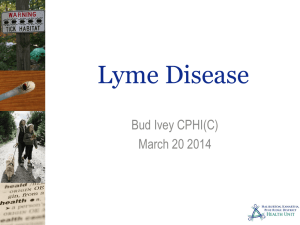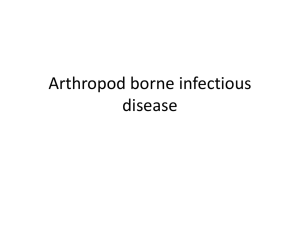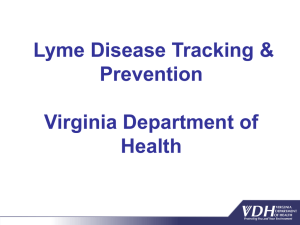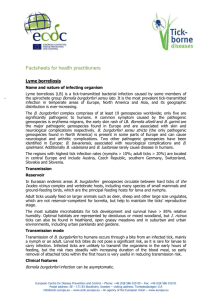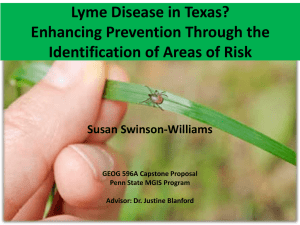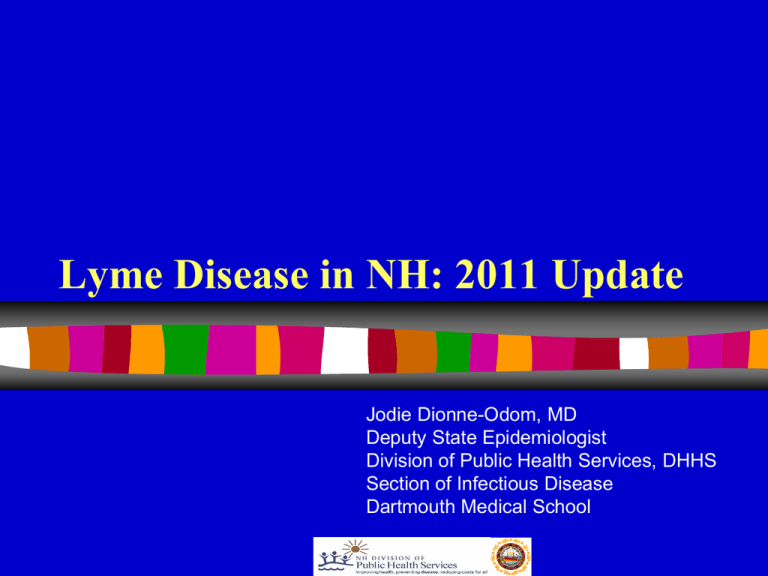
Lyme Disease in NH: 2011 Update
Jodie Dionne-Odom, MD
Deputy State Epidemiologist
Division of Public Health Services, DHHS
Section of Infectious Disease
Dartmouth Medical School
Outline
History
Tick Biology and Ecology
Surveillance
National and Local Epidemiology
Clinical Manifestations
Management
Prevention
US HISTORY
Lyme Disease
First recognized US 1975
– Many juvenile
rheumatoid arthritis
cases around Lyme, CT
– In Europe, similar skin
rashes and
meningopolyneuritis
described for 100 years.
In 1983, both syndromes
linked after recovery of the
spirochete in a patient.
THE ORGANISM
Biology of Lyme Disease
This bacteria is difficult to culture.
Extracellular pathogen
B. burgdorferi is carried by ticks.
– Vector = Ixodes
Lyme disease is now the most common
vector-borne disease in the US and
Europe.
Geography
Worldwide in
temperate zones:
– North America
• Northeast: Maine
to Maryland
• Mid West:
Wisconsin and
Minnesota
• West Coast:
California and
Oregon
– Europe (forested
areas) – B. garinii
– Northern Asia
THE VECTOR
(bug warning)
American dog tick = Dermacentor variabilis
Dog Ticks (aka Wood Ticks)
American dog tick
Photo credit: U of MN Entomology Dept.
The Life Story of Ixodes scapularis
Larval, nymph and adult stages.
1. Adults peak in spring and fall – preferred
host is white-tailed deer. Mating occurs.
2. Nymphs peak May-July – aggressive frequently bite humans
3. Larvae peak August-September (from eggs
on the ground)
Reservoir Hosts
Deer, wild rodents, and other animals
– White-footed mice are preferential hosts for
larval and nymphs (Mice maintain
spirochetemia)
SURVEILLANCE
Case Classification 2011
Confirmed: a) case of EM with a known exposure
b) case of EM with laboratory evidence of infection
c) a case with at least one late manifestation with lab
evidence of infection.
Probable: case of physician-diagnosed Lyme disease
with lab evidence of infection
Suspected: a) a case of EM with no known exposure or
lab evidence of infection
b) a case with lab evidence of infection but no clinical
information.
Surveillance Case definition 2011
Laboratory criteria for diagnosis
1. Positive Culture for B. burgdorferi
2. Two-tier testing interpreted using
established criteria:
1. ELISA, then Western Blot (IgM and IgG)
3. Single-tier IgG immunoblot seropositivity
using established criteria.
4. CSF antibody positive for B. burgdorferi
US EPIDEMIOLOGY
NH EPIDEMIOLOGY
Lyme Disease Surveillance in NH
Reportable in NH since 1990
1991-1999: 15-47 cases per year
Increasing incidence began in 2000
– 124 cases in 2000
– 1,621 cases in 2008 (peak)
2nd most common reportable
infectious disease
Annual Incidence of Reported
Lyme Cases in NH, 1991-2006
Cases per 100,000
50
40
30
20
10
0
9
19
1
9
19
3
9
19
5
9
19
7
9
19
Year
9
0
20
1
0
20
3
0
20
5
Reported Lyme Disease
Incidence per 100,000 Persons, 2001-2010
New Hampshire Rate
National Rate
Connecticut Rate
160.0
140.0
Rate per 100,000
120.0
100.0
80.0
60.0
40.0
20.0
0.0
2001 2002 2003 2004 2005 2006 2007 2008 2009 2010
Year
Highest Incidence States,
Selected Years, 1992-2009
2nd
3rd
1992 Connecticut (Rate:
53.7)
Delaware
(Rate: 31.7)
Rhode Island (Rate:
27.5)
2000 Connecticut (Rate:
104.8)
Rhode Island
(Rate: 64.2)
New Jersey (Rate:
29.2)
Year
1st
2008
New Hampshire
(Rate: 92.0)
Delaware
(Rate: 88.4)
Massachusetts
(Rate: 60.9)
2009
Delaware
(Rate: 111.2)
Connecticut
(Rate: 78.2)
New Hampshire
(Rate: 75.2)
Reporting Process
In 2006, all reported cases were assigned
to a public health nurse for investigation
– Called provided to collect symptom, treatment,
and exposure information
>100% increase in 2006
– 271 cases in 2005 vs. 617 cases in 2006
In 2007, a letter system implemented to
reduce burden to public health staff
– Collected surveillance data via form mailed to
all providers ordering a Lyme disease test with
a positive result
2010 Lyme Disease Investigations
A total of 2,002 Lyme disease reports
received
826 (41%) Confirmed
509 (25%) Probable
175 (9%) Suspect (missing information)
492 (25%) did not meet case definition
Data including 2010
NH LYME MAP 2002-2010
Active Surveillance for Borrelia in
New Hampshire Deer Ticks
Fall 2007, Fall 2008, and Fall 2009 deer ticks
were collected from all ten NH counties
Ticks were tested for presence of Borrelia
burgdorferi by PCR
Fewer than 20 ticks were collected from 4
counties and data could not be analyzed
Overall state proportion of ticks infected was
60% (686 of 1,140 ticks collected)
Babesia and Anaplasma also detected at lower
rates (<10%) though testing not complete
2007- 2009 Fall Tick Collections
2007- 2010 Fall Tick Collections
Number of Reported Lyme Disease Cases by Month,
New Hampshire, 2006-2010
Number of Reported Cases
2006
2007
2008
2009
2010
600
550
500
450
400
350
300
250
200
150
100
50
0
Jan
Feb
*Rate per 100,000 persons
Mar
Apr
May
Jun
Jul
Month
Aug
Sep
Oct
Nov
Dec
Average Annual Incidence of Reported Cases of Lyme Disease by Age
Group and Sex, New Hampshire, 2006-2010
Male
Female
200
180
Cases per 100,000
160
140
120
100
80
60
40
20
0
0-4
5-9
10-14 15-19 20-24 25-29 30-34 35-39 40-44 45-49 50-54 55-59 60-64 65-69 70-74 75-79 80-84
Overall Male rate per 100,000: 95.5
Overall Female rate per 100,000: 82.1
Age (years)
>84
Reported Clinical Findings for Confirmed Lyme
Disease Cases New Hampshire, 2009
40.0%
36.7%
35.0%
30.2%
30.0%
25.0%
Percentage of
all Reports
20.0%
15.0%
10.0%
5.7%
0.5%
0.4%
2nd or 3rd degree
atrioventricular
block
0.6%
Lymphatic
meningitis
3.2%
5.0%
Encephalitis
Radiculoneuropathy
Bell's Palsy/ Cranial
Neuritis
Arthritis
Erythema Migrans
0.0%
Coinfections
Disease
2006
2007
2008
2009
2010
Anaplasmosis 0
3
14
18
19
Babesiosis
3
3
8
7
10
Ehrlichiosis
3
1
7
6
6
NH Surveillance Data on the Web
Maps
Data Reports
Incidence by County
http://www.dhhs.nh.gov/dphs/cdcs/lyme/p
ublications.htm
CLINICAL DISEASE
Lyme Disease - Clinical Features (2)
Incubation : 3 to 32 days
Early localized disease
• within 1 month of infection
• Slowly expanding skin lesion (80%):
erythema migrans rash
• Usually accompanied by influenza-like
illness:headache, arthralgias, myalgias,
fever, lymphadenopathy.
Lyme Disease - Clinical Features (3)
Early disseminated disease
– Weeks to months after initial infection
– Can involve skin, joints, heart, CNS
– Neurologic disease in 15 % of untreated
patients
•
•
•
•
•
Lymphocytic meningitis with episodic headaches
Subtle encephalitis with difficult mentation
Motor or sensory radiculoneuritis
Spinal radicular pain or distal paresthesias
Lyme encephalopathy: subtle cognitive
disturbances
Lyme Disease - Clinical Features (4)
Early disseminated disease
– Cardiac disease in 5% of untreated
patients
– Musculoskeletal involvement in
60% of untreated patients
• Intermittent attacks of joint swelling
and pain (knee)
Lyme Disease - Clinical Features (5)
Late disseminated
disease
• months to years
after initial
infection
• Lyme arthritis,
neuroborreliosis
Lyme Disease – Diagnosis (1)
Suspicion based on clinical
findings and epidemiology
Antibody assays support clinical
diagnosis
Interpretation of tests can be
complicated
Make sure the testing lab is
approved
Lyme Disease – Diagnosis (2)
Serologic testing can be negative early
– EM may occur before antibody has time to
develop
– Sensitivity of serology 59% in early LD
– Negative serology with EM should not
preclude diagnosis
Lyme Disease – Diagnosis (3)
Two test approach:
– ELISA Antibody test
– If ELISA positive, check western blot
test.
WB: IgG (chronic) and IgM (acute)
– IgG + requires 5 bands out of 10
– IgM + requires 2 bands out of 3
Source: Lyme Disease. NEJM, Vol 345, no 2. July 12, 2001
Lyme Disease – Diagnosis (4)
Disseminated or late stage : almost
always strong IgG response.
PCR in joint fluid
Titers can persist many years after
treatment
Treatment for Reported Cases, 2009
Treatment
Doxycycline
Amoxicillin
Other
Unknown
No Response
Total
% of Cases
65.1
12.7
7.7
6.6
7.9
100
Lyme Disease – Prevention (1)
Avoidance of tickinfested habitat
Tick repellent, tick
checks
Prevention (2)
Wear enclosed shoes and light-colored
clothing with a tight weave to spot ticks easily
If possible, wear long pants and tuck them
into the socks
Scan clothes and any exposed skin
frequently for ticks while outdoors
Stay on cleared, well-traveled trails
Use insect repellant containing DEET on skin
or clothes if you intend to go off-trail or into
overgrown areas
Prevention (3)
Avoid sitting directly on the ground or on
stone walls (havens for ticks and their hosts)
Keep long hair tied back, especially when
gardening
Do a final, full-body tick-check at the end of
the day (also check children and pets)
Upon returning home, clothes can be spun in
the dryer for 20 minutes to kill any unseen
ticks
Prevention (4)
To remove a tick, follow
these steps (36 hour rule):
1. Using tweezers, grasp the tick by the head or
mouthparts right where they enter the skin. DO NOT
grasp the tick by the body.
2. Pull firmly and steadily directly outward. DO NOT
twist the tick out or apply petroleum jelly, a hot
match, alcohol or any other irritant to the tick in an
attempt to get it to back out.
3. Place the tick in a vial or jar of alcohol to kill it.
4. Clean the bite wound with disinfectant.
Prevention (at home) (5)
Keep lawn mowed and edges trimmed.
Clear brush, leaf litter and tall grass around houses
and at the edges of gardens and open stone walls.
Stack woodpiles neatly in a dry location and
preferably off the ground.
Clear all leaf litter (including the remains of
perennials) out of the garden in the fall.
Keep ground under bird feeders clean so as not to
attract small mammals.
Lyme Disease – Prevention (6)
Medical Prophylaxis after a tick
bite = 200 mg doxycycline
IF four criteria are met:
1. deer tick
2. attached for >36 hours
3. within 72 hours of exposure
4. Exposure to high risk area (most
of NH)
Lyme Disease – Prevention (7)
LYMErix vaccine (approved in 1998)
• 76% effective in preventing clinical LD
• persons in moderate or high risk areas
with “frequent or prolonged exposure”
to tick habitat
Removed from the market in 2002
New push for research to create a
new Lyme vaccine
MMWR. May 7, 2004 / 53(17);365-369
Questions?
Thank you


